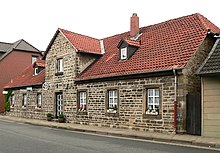Poor house



The poor house , formerly also Ptochodochium (to gr. Ptōchós "beggar" and gr. Nochḗ "admission"), developed in the early modern period from the medieval hospice and hospital . It was often linked to an orphanage , prison , hospital, or workhouse .
description
Elderly people who were no longer able to support themselves lived in poor houses. There they received a place to live and daily food. The poor houses used to be part of the cityscape and only accepted impoverished residents from their own city . Strangers were not given this pension . In contrast to the workhouses, the poorhouses were generally not closed institutions and admission was - at least formally - voluntary.
As a rule, poor houses were financed by grants from wealthy citizens and by grants from the city and church . In rural areas, poor relief was partly paid for from the common good ( commons ).
Today the term poorhouse is almost only used in a figurative sense, for example a country is described as "the poor house of Africa" or a city as "the poor house of the region".
See also
literature
- Eva-Maria Lerche: Everyday life and living environment of the homeless poor. A micro-study of the inmates of the Westphalian country poor house Benninghausen (1844-1891). Waxmann, Münster 2009, ISBN 978-3-8309-2210-0 ( Contributions to folk culture in Northwest Germany. 113).
- Dominik Nagl: No Part of the Mother Country, but Distinct Dominions Legal Transfer, State Building and Governance in England, Massachusetts and South Carolina, 1630–1769. LIT, Berlin 2013, ISBN 978-3-643-11817-2 , p. 151ff. ( online ).
- Kirsten Bernhardt: poor houses. The foundations of the Münsterland nobility (16th – 20th centuries). Münster 2012, ISBN 978-3-8309-2576-7 .
Individual evidence
- ↑ Ptochiater. In: Herders Conversations-Lexikon. Freiburg im Breisgau 1856, Volume 4, p. 632.
- ↑ Cf. the Dresden house rules from 1888 in the collection of sources on the history of German social policy 1867 to 1914 , Section II: From the Imperial Social Message to the February Decrees of Wilhelm II (1881-1890) , Volume 7: Communal Poor Care , edited by Wilfried Rudloff, Darmstadt 2015, No. 106.
- ↑ However, the voluntary and compulsory institutional accommodation was not infrequently carried out in the same institution, cf. Wolfgang Ayaß : The work house in Breitenau. Beggars, vagrants, prostitutes, pimps and welfare recipients in the correctional and rural poor institution in Breitenau (1874–1949). , Kassel 1992.
- ↑ Cf. Christina Vanja : Review of: Lerche, Eva-Maria: Everyday life and living environment of the homeless poor. A micro-study of the inmates of the Westphalian country poor house Benninghausen (1844-1891). Munster 2009 . In: H-Soz-u-Kult , January 12, 2010.
